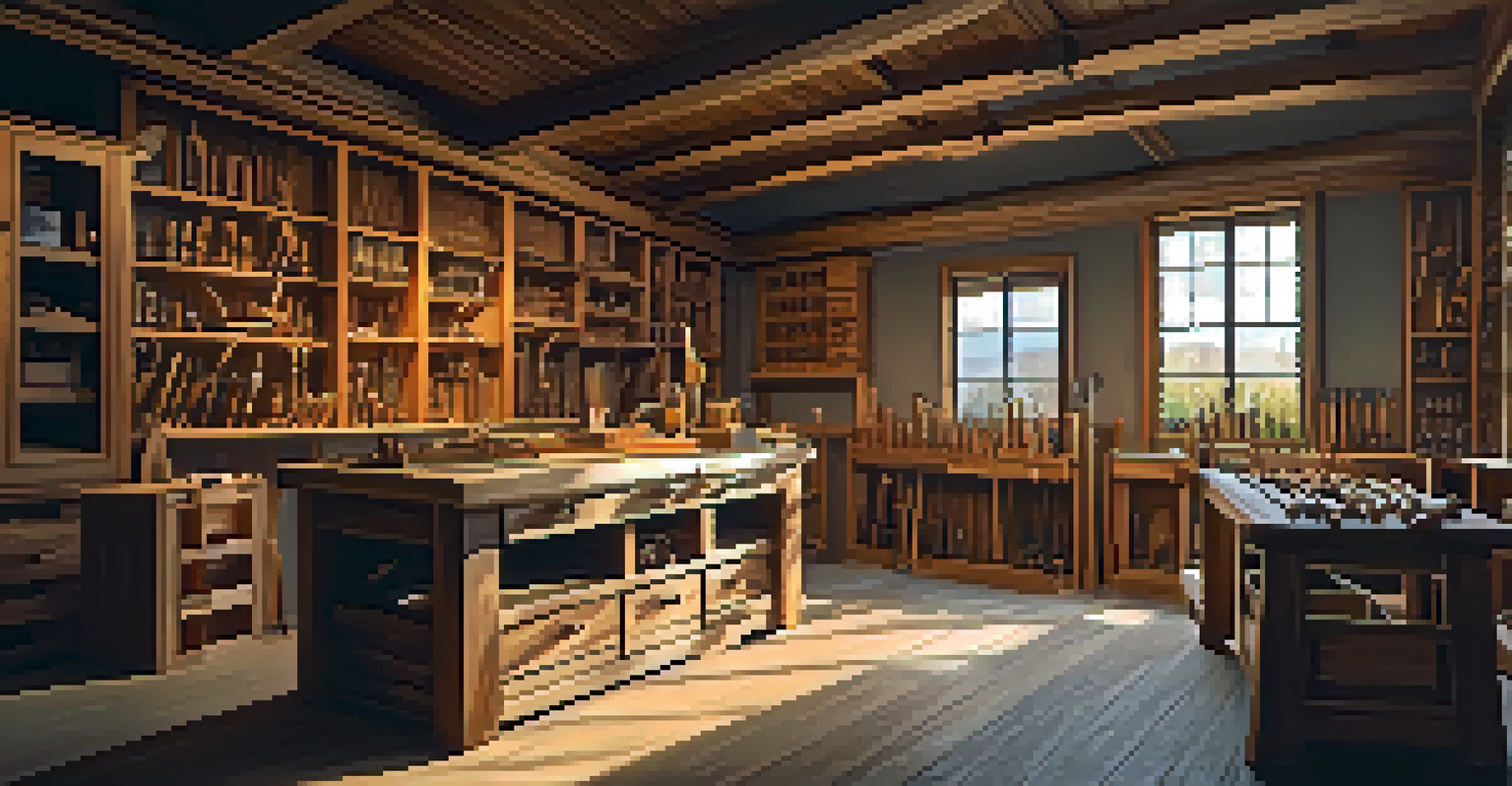Woodworking Styles: Exploring Popular Design Aesthetics

Understanding the Essence of Woodworking Styles
Woodworking styles encompass various design aesthetics that reflect cultural influences, historical periods, and personal preferences. Each style tells a story, capturing the craftsmanship and creativity of artisans throughout time. By understanding these styles, you can appreciate the intricate details and unique features that make each piece special.
The only limit to your impact is your imagination and commitment.
From the clean lines of modern design to the ornate details of traditional craftsmanship, woodworking styles offer something for everyone. Whether you're looking to furnish your home or simply appreciate the art of woodworking, knowing the different styles helps in making informed design choices. This exploration opens up a world of creativity and inspiration.
In this article, we'll delve into some of the most popular woodworking styles, examining their characteristics, origins, and what makes them stand out. So, grab your favorite cup of coffee and get ready to explore the fascinating world of woodworking aesthetics!
The Timeless Charm of Traditional Woodworking
Traditional woodworking styles often draw inspiration from historical periods and techniques, emphasizing craftsmanship and attention to detail. Think of intricate carvings, dovetail joints, and rich woods like oak and mahogany. These styles have stood the test of time, appealing to those who appreciate vintage aesthetics and classic design.

One notable example is the Colonial style, which features symmetrical designs, functional furniture, and a warm, inviting appeal. This style reflects a sense of history and nostalgia, making it a favorite for those who want to recreate a classic look in their homes. Traditional woodworking brings a cozy, timeless feel that never goes out of style.
Diverse Woodworking Styles Exist
Woodworking styles encompass a variety of design aesthetics that reflect cultural influences and personal preferences.
Another aspect of traditional woodworking is its focus on sustainability, often using locally sourced, reclaimed wood. This not only adds character to each piece but also supports eco-friendly practices. Embracing traditional woodworking means appreciating the enduring beauty of craftsmanship and the stories behind each creation.
Exploring the Clean Lines of Modern Woodworking
Modern woodworking is characterized by its minimalist approach, focusing on clean lines and functional design. This style strips away unnecessary ornamentation, allowing the beauty of the wood itself to shine through. Think of sleek furniture pieces that emphasize form and function, appealing to contemporary tastes.
Woodworking is not just a craft, it is a way of life that reflects the beauty of nature and the skill of the artisan.
A common feature of modern woodworking is the use of materials like plywood and laminates alongside natural woods, creating a fresh and innovative look. The emphasis is on simplicity, often resulting in furniture that is both practical and aesthetically pleasing. This style resonates with those who appreciate a clutter-free, modern lifestyle.
Moreover, modern woodworking often incorporates technology, such as CNC machining, to achieve precision in design. This blend of artistry and technology opens up new possibilities in woodworking, making it an exciting style to explore. Whether you’re furnishing a sleek apartment or a cozy home, modern woodworking offers versatility and style.
Rustic Woodworking: Embracing Nature's Imperfections
Rustic woodworking celebrates the natural beauty of wood, often showcasing its imperfections and unique character. This style is all about warmth and authenticity, evoking a sense of the great outdoors. Think of weathered barnwood furniture or log cabin accents that bring the charm of nature indoors.
A key element of rustic woodworking is the use of reclaimed or salvaged materials, adding a layer of history and sustainability to each piece. These materials often come with their own stories, making rustic furniture not just functional but also a conversation starter. The imperfections in the wood tell tales of time, which many find appealing.
Traditional Craftsmanship Shines
Traditional woodworking emphasizes intricate details and sustainability, creating timeless pieces that evoke nostalgia.
Moreover, rustic woodworking encourages a connection to nature, often incorporating natural finishes that highlight the wood's grain and texture. This style is perfect for those who love a cozy, casual atmosphere in their living spaces. Embracing rustic woodworking means inviting the beauty of the outdoors into your home.
The Elegance of Scandinavian Woodworking
Scandinavian woodworking is known for its clean, functional designs that emphasize simplicity and minimalism. This style combines beauty with practicality, often featuring light-colored woods like birch and pine. It's about creating spaces that feel open and inviting while still being stylish and functional.
One of the hallmarks of Scandinavian design is the use of organic shapes and natural materials, which creates a warm and cozy ambiance. Furniture pieces often have a light, airy quality, making them suitable for a range of interiors. This aesthetic resonates with those who appreciate both modernity and warmth in their living spaces.
Additionally, Scandinavian woodworking often incorporates sustainable practices, reflecting a deep respect for nature. This commitment to eco-friendly design enhances its appeal, as more people seek ways to reduce their environmental impact. Embracing Scandinavian woodworking means embracing a lifestyle that values both style and sustainability.
Industrial Woodworking: A Fusion of Raw and Refined
Industrial woodworking is a bold style that combines raw materials with sleek designs, often highlighting the beauty of metal and wood together. This aesthetic emerged from the industrial revolution, characterized by exposed beams, metal accents, and a rugged, unfinished look. It's perfect for those who appreciate an edgy, urban vibe in their home decor.
A key feature of industrial woodworking is the use of reclaimed wood, which adds character and history to furniture pieces. Iron pipes and reclaimed wood tables are common examples, showcasing a mix of textures that create visual interest. This style appeals to those who want their spaces to reflect a sense of creativity and individuality.
Personalize Your Woodworking Choices
Finding a woodworking style that resonates with you allows for creativity and personalization in your living space.
Furthermore, industrial design often embraces open spaces and a functional layout, making it ideal for loft-style living. It’s a style that encourages flexibility and creativity, allowing homeowners to express their personalities through their decor. If you're drawn to a unique, eclectic look, industrial woodworking can be a perfect fit for your home.
Artisan Woodworking: The Craftsmanship Behind Unique Pieces
Artisan woodworking focuses on handmade pieces that embody craftsmanship and artistry, often resulting in one-of-a-kind creations. This style emphasizes the skill of the woodworker, showcasing intricate details and personalized designs that you won't find in mass-produced furniture. It's about celebrating the human touch in every piece.
Artisan woodworkers often use traditional techniques passed down through generations, blending them with modern aesthetics. This results in furniture that is not just functional but also a work of art. Each piece tells a story, reflecting the passion and dedication of the craftsman behind it.

Moreover, artisan woodworking supports local economies and sustainable practices, as many artisans source their materials responsibly. Investing in artisan pieces means bringing home unique furniture that adds character to your space while supporting skilled craftspeople. If you're looking for something special, artisan woodworking offers a world of creativity and beauty.
Finding Your Style: Personalizing Your Woodworking Choices
With such a diverse range of woodworking styles available, finding the one that resonates with you is key to creating a space that feels like home. Start by considering your personal preferences, lifestyle, and the overall vibe you want to achieve. Whether you lean towards rustic charm or modern minimalism, there's a style that will suit your taste.
Don’t be afraid to mix and match elements from different styles to create a unique look that reflects your personality. Combining rustic and modern pieces, for example, can create an inviting yet contemporary atmosphere. The beauty of woodworking is that it allows for endless creativity and personalization.
Lastly, remember that your woodworking choices should bring you joy and comfort. Take your time to explore different styles, visit local artisans, and find pieces that speak to you. Ultimately, your space should be a reflection of who you are, making it a true sanctuary for you and your loved ones.